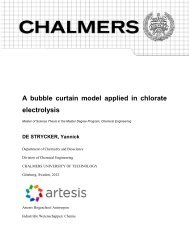A computational grammar and lexicon for Maltese
A computational grammar and lexicon for Maltese
A computational grammar and lexicon for Maltese
Create successful ePaper yourself
Turn your PDF publications into a flip-book with our unique Google optimized e-Paper software.
2.2.2 Verb<br />
The verb is arguably the most interesting aspect of <strong>Maltese</strong> morphology. As described in section<br />
1.1.2, <strong>Maltese</strong> verbs can be divided more or less cleanly in two groups: those which follow<br />
a Semitic root-<strong>and</strong>-pattern morphology, <strong>and</strong> those which display a concatenative morphology.<br />
(Spagnol, 2011) Most of the work on morphology concerns the <strong>for</strong>mer group as their conjugations<br />
are much more involved.<br />
Etymologically, verbs in <strong>Maltese</strong> can roughly be divided into Semitic, Romance <strong>and</strong> English<br />
origin. While all the Semitic verbs follow a root-<strong>and</strong>-pattern morphology, there is a division in<br />
the Romance class of verbs. Some have become strongly-integrated into the root <strong>and</strong> pattern<br />
system <strong>and</strong> behave as quadriliteral verbs. Examples include kanta (‘he sang’), vinċa (‘he won’)<br />
<strong>and</strong> serva (‘he served’), from the Italian cantare, vincere <strong>and</strong> servire respectively. These are treated<br />
as Semitic verbs as quadriliteral verbs with the weak j as final radical.<br />
The remainder of <strong>Maltese</strong> verbs from Romance origin are only loosely-integrated <strong>and</strong> follow<br />
a concatenative morphology of stems <strong>and</strong> affixes. Examples include żviluppa (‘he developed’),<br />
ipperfezzjona (‘he perfected’), antagonizza (‘he antagonised’). The third group of verbs<br />
have an English origin, <strong>and</strong> follow the same morphology as the loosely-integrated Romance<br />
verbs, Examples include ibbukja (‘he booked’), ipparkja (‘he parked’), iffittja (‘he fitted’). Despite<br />
their different etymology, these two latter groups behave identically from a morphological<br />
perspective <strong>and</strong> thus are not distinguished between in the <strong>grammar</strong>; they are both treated generically<br />
as loan verbs.<br />
Classification<br />
The classification of <strong>Maltese</strong> verbs is covered significantly elsewhere (Borg & Azzopardi-Alex<strong>and</strong>er,<br />
1997; Brother Henry F.S.C., 1980; Spagnol, 2011; Fabri, 2009). While broadly following this linguistic<br />
tradition, we are also interested in keeping representations <strong>and</strong> compact efficient. Table<br />
2.1 shows the verb classification as used in the resource <strong>grammar</strong>. The liquid-medial class corresponds<br />
to Fabri’s ITb paradigm (Fabri, 2009) (where regular is ITa), which require an epenthetic<br />
vowel to be inserted in the imperfective paradigm (Spagnol, 2011, p. 38). As noted but<br />
Fabri (2009), għ is not weak, thus defective verbs are technically strong. However, they behave<br />
inflectionally as weak verbs <strong>and</strong> are thus classified as such in our case.<br />
Table 2.1: Verb classes <strong>and</strong> their characteristics<br />
Class Description Example<br />
Strong<br />
Regular All radicals strong & distinct qatel (‘he killed’) ( √ QTL)<br />
Liquid-medial C2 is liquid żelaq (‘he slipped’) ( √ żLQ)<br />
Geminated C2 & C3 are identical ħabb (‘he loved’) ( √ ħBB)<br />
Weak<br />
Continued on next page<br />
20















